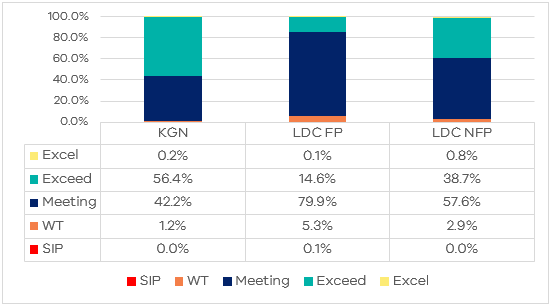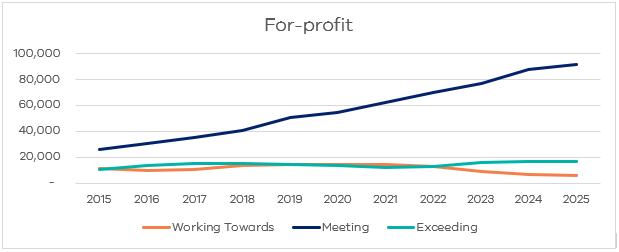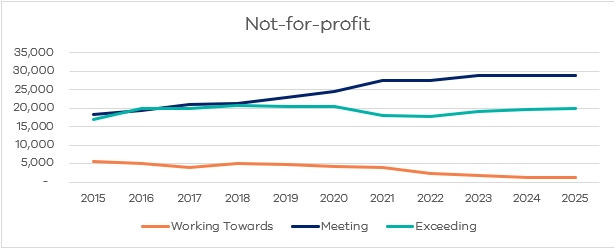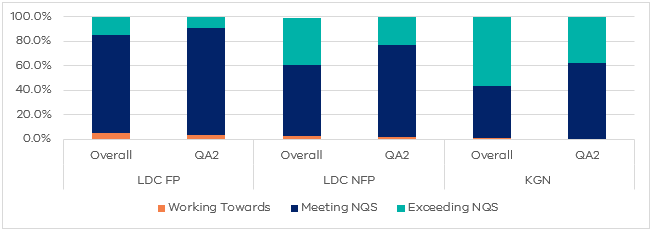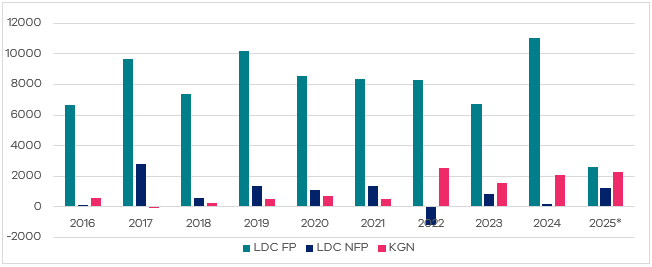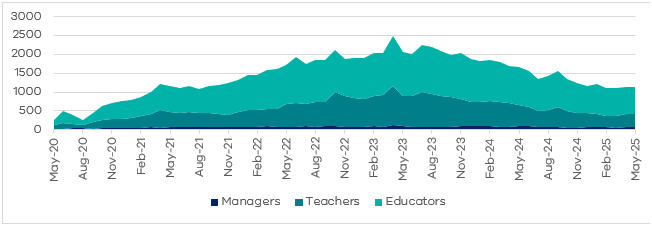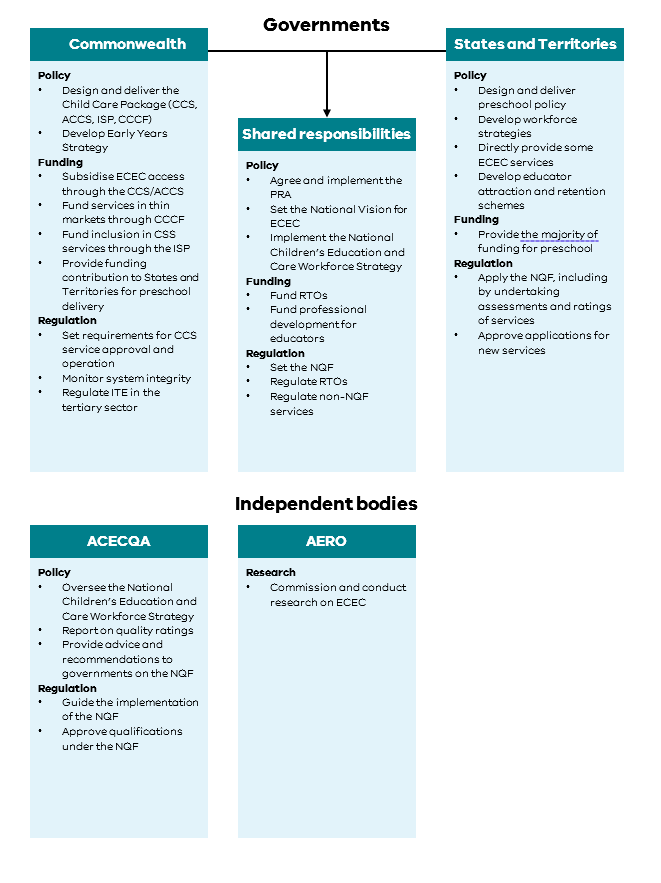This appendix provides background on key aspects of the ECEC system in Victoria.
1. What is early childhood education and care?
The ECEC system performs 2 important functions.
The first function is to provide early childhood education to children. As any parent knows, young children are always learning, wherever they are—exploring the world around them, asking questions, and developing new skills and abilities. Skilled educators (and some teachers) support children to do this—they engage purposefully with children to support their learning and wellbeing.
The second function of ECEC is to provide a safe, supportive and nurturing environment for children that supports their education and development, while their parents do other things such as work or study. This is often considered the ‘care’ aspect of early childhood education and care.
2. Types of services
There are 3 main types of ECEC services in Victoria for children before they reach school age. These services are set out in Table A2.1 below. Outside school hours care is also a part of the early childhood education and care system and focusses on school-aged children.
| Long day care services |
|---|
|
| Standalone kindergarten services |
|---|
|
| Family day care |
|---|
|
Unless specified, the analysis in this appendix relates to long day care and standalone kindergarten services in Victoria, as this has been the focus of the Review’s work.
3. Children in ECEC services
In 2024, 69,802 children participated in three-year-old kindergarten (90.1 per cent of those were eligible), for an average of 13.8 hour per week, and 78,554 participated in the 15 hour per week four-year-old kindergarten program (96 per cent of those were eligible).
In the 3 months to March 2025, 219,020 children from 178,650 families attended a long day care service as part of the child care subsidy system in Victoria, for an average of 34.1 hours per week.
In the same period, 21,910 children from 14,510 families attended a family day care service.
4. Service quality
Child safety is an essential aspect of service quality and is regulated under the National Quality Framework (see Appendix 3). Each ECEC service in Australia is rated against a consistent National Quality Standard. Services can be assessed as: Significant Improvement Required; Working Towards the National Quality Standard; Meeting the National Quality Standard or Exceeding the National Quality Standard. Services that Exceed the National Quality Standard in all areas can apply to be rated by the Australian Children’s Education and Care Quality Authority as ‘Excellent’, which recognises exceptional education and care, leadership and commitment to sustained excellent practice.
Figure A2.1 below provides an overview of the current rating of services in Victoria, separated into stand-alone kindergartens, for-profit long day care and not-for-profit long day care. It shows the proportion of each service type that is rated at each level, with the vast majority of services at least ‘Meeting’ the National Quality Standard. It shows that for-profit long day care services in Victoria are more likely to be Working Towards the National Quality Standard than not-for-profit long day care services (5.3 per cent compared to 2.9 per cent), and less likely to exceed the National Quality Standard (14.6 per cent compared to 38.7 per cent). Only one long day care service in Victoria is rated ‘Significant Improvement Required’.
Note: ‘KGN’ is stand-alone Kindergarten; ‘LDC FP’ is long day care for-profit; ‘LDC NFP’ is long day care not-for-profit; ‘SIP’ is Significant Improvement Required; ‘WT’ is Working Towards; ‘Exceed’ is Exceeding and ‘Excel’ is Excellent.
Nationally, the proportion of services at least ‘Meeting’ the National Quality Standard has grown steadily over time and has risen from 53 per cent in 2013 to 90 per cent in 2023. A similar trend is observable in Victoria.
In more recent years, the trend in quality improvement has changed. While more of the system meets the National Quality Standard and fewer services are working towards the National Quality Standard, the proportion of the system that exceeds the National Quality Standard has fallen. This is illustrated in Figure A2.2 below.
Note: Excludes ‘Significant Improved Required’ and ‘Excellent’ ratings
Figure A2.3 below shows this trend in quality rating for the for-profit and not-for-profit long day care services by total number of places.
Children’s health and safety
Quality Area 2 of the National Quality Standard focusses on children’s health and safety. As shown in Figure A2.4 below, all service types are less likely to be ‘Working Towards’ Quality Area 2 than the National Quality Standard overall, and less likely to ‘Exceed’ Quality Area 2 than the National Quality Standard overall. It shows for-profit long day care services are more likely to be working towards Quality Area 2 than not-for-profit long day care services (3.4 per cent compared to 2.2 per cent), and less likely to exceed Quality Area 2 (8.8 per cent compared to 23.4 per cent). No service in Victoria was rated ‘significant improvement required’ for Quality Area 2.
Note: ‘KGN’ is stand-alone Kindergarten; ‘LDC FP’ is long day care for-profit; ‘LDC NFP’ is long day care not-for-profit; ‘QA2’ is Quality Area 2.
5. System growth and composition
The system has expanded significantly over the past decade. About 90 per cent of the growth in services and 80 per cent in the growth in places has come from for-profit long day care services. Growth in not-for-profit long day care and standalone kindergarten services has been lower, as shown in Tables A2.2 and A2.3 below.
| 2015 | 2025 | Change | % change | Share of growth | |
| Total | 2,477 | 3,285 | 808 | 32.6% | |
| Long day care | 1,280 | 2,049 | 769 | 60.1% | 95.2% |
| Standalone kindergartens | 1,197 | 1,236 | 39 | 3.3% | 4.8% |
| For-profit long day care | 696 | 1,422 | 726 | 104.3% | 89.9% |
| Not-for-profit long day care | 584 | 627 | 43 | 7.4% | 5.3% |
| 2015 | 2025 | Change | % change | Share of growth | |
| Total | 151,218 | 250,169 | 98,951 | 65.4% | |
| Long day care | 101,440 | 189,370 | 87,930 | 86.7% | 88.9% |
| Standalone Kindergartens | 49,778 | 60,799 | 11,021 | 22.1% | 11.1% |
| For-profit long day care | 55,971 | 135,463 | 79,492 | 142.0% | 80.3% |
| Not-for-profit long day care | 45,469 | 53,907 | 8,438 | 18.6% | 8.5% |
Figure A2.5 below shows the annual growth in places, by provider type, noting that the 2025 data is for the first quarter only, and new standalone kindergartens are more likely to open at the start of the school year.
Note: ‘LDC FP’ is long day care for-profit; ‘LDC NFP’ is long day care not-for-profit; ‘KGN’ is standalone kindergarten.
Provider scale
In Victoria the 2,049 long day care services and 1,236 standalone kindergartens are operated by 1,424 different Approved Providers.
Of the 1,424 Approved Providers operating long day care or standalone kindergartens, 1,128 operate only one service in Victoria. 42 providers operate 10 or more services, and these providers operate more than half of all standalone kindergartens and 40 per cent of all long day care services, shown in Table A2.4 below.
| Number of services | Number of providers | Total services | % of total services | % of total places | Long day care services | % total Long day care services | Standalone kindergarten services | % total Standalone kindergarten |
| 1 | 1,128 | 1,128 | 34.3% | 34.7% | 769 | 37.5% | 359 | 29.0% |
| 2 | 150 | 300 | 9.1% | 9.7% | 260 | 12.7% | 40 | 3.2% |
| 3-5 | 81 | 297 | 9.0% | 9.6% | 222 | 10.8% | 75 | 6.1% |
| 6-9 | 23 | 168 | 5.1% | 5.4% | 105 | 5.1% | 63 | 5.1% |
| 10-19 | 19 | 280 | 8.5% | 8.6% | 156 | 7.6% | 124 | 10.0% |
| 20+ | 23 | 1,112 | 33.9% | 32.0% | 537 | 26.2% | 575 | 46.5% |
| Total | 1,424 | 3,285 | 2,049 | 1,236 |
In Victoria, many standalone kindergarten services are operated by an Early Years Manager as the Approved Provider. In 2024, 1,083 services were part of an Early Years Manager.
This analysis only considers a provider’s Victorian services; many providers operate nationally. It is based on Approved Providers as listed in the National Register, which may not capture relationships between individual Approved Providers.
6. Workforce
In Victoria, about 39,000 people work in long day care and 8,500 work in standalone kindergarten services. Of these staff:
- 96.1 per cent are female
- 82.4 per cent are permanent and 14.4 per cent are casual
- 62.7 per cent work part time (less than 35 hours a week).
The sector is characterised by high levels of staff turnover. 67.1 per cent of contact staff have 3 or fewer years of experience with their current service, including 22.7 per cent with less than one year. The Review heard of forthcoming Australian research that shows, in the toddler rooms that were studied, children had a new educator every 7 weeks, on average, but the study considered this is likely to be an underestimate.
In some areas, there are differences in the workforce between long day care and standalone kindergartens services:
- Long day care staff are more likely to be casual (15.7 per cent compared to 8.4 per cent in standalone kindergarten services).
- Long day care staff are more likely to work full time hours (35 or more hours in a week, 42.1 per cent compared to 15.2 per cent).
- Long day care staff have fewer years of experience in the sector (40 per cent have 3 or fewer years, compared to 18.8 per cent for kindergartens, and 48.6 per cent of kindergarten staff have more than 10 years of experience, compared to 25.3 per cent of long day care staff).
- Staff in a standalone kindergarten service are more likely to have a bachelor’s degree (41.7 per cent compared to 15 per cent of long day care staff). Long day care staff are more likely to have a diploma or certificate level qualification. 21 per cent of long day care staff are studying (this data includes staff upskilling from an existing qualification and is not available for standalone kindergarten service staff).
- The age profile of the 2 service types is also different (42.3 per cent of long day care contact staff are under 35, compared to 16.8 per cent of standalone kindergarten staff).
Workforce challenges in the ECEC system have become more acute and prominent in recent years, when many services had to cap enrolments or close rooms because they could not find sufficient staff to operate.
Following a multi-employer bargaining process, the Commonwealth Government has instituted a Worker Retention Payment that funds long day care services to increase pay by 15 per cent over 2 years. Figure A2.6 below shows that vacancies have declined from their recent peaks.
In Victoria, by some measures, workforce challenges have been less severe.
Victoria has the lowest proportion of services with a staffing waiver: 1.2 per cent at 1 April 2025, compared to a national average of 7.9 per cent of services.
The long day care workforce
In 2023, the Australian Competition and Consumer Commission collected and analysed a set of data from childcare services, including data related to pay and conditions. While there are some important caveats to its analysis, it provides insight into some aspects of the system.
In looking at large providers, the Australian Competition and Consumer Commission found that labour costs were a higher proportion of total costs in not-for-profit providers (77 per cent) than for-profit providers (63 per cent). These not-for-profit staff were more likely to be higher paid, with 94.5 per cent of not-for-profit staff paid above award rate, compared to 64.3 per cent of for-profit staff.
Small and medium not-for-profit providers were also more likely to pay staff above the award wage, with 75.3 per cent of staff at these services paid above award, compared to 45.9 per cent for small and medium for-profit providers.
Analysis of the 2024 Early Childhood Education and Care Workforce Census, undertaken for this Review by the Commonwealth Government Department of Education, found that long day care services where more than 50 per cent of paid contact workers were paid above the award rate were more likely to be rated as ‘Exceeding the National Quality Standard’, and less likely to be rated as ‘Working Towards the National Quality Standard’, than services where fewer than 50 per cent of paid contact workers were paid above the award rate.
The Australian Competition and Consumer Commission also found large not-for-profit providers had:
- a higher proportion of full-time contact staff than for-profits (47 per cent compared to 25 per cent)
- lower vacancies (9.7 per cent compared to 22 per cent)
- lower turnover (27 per cent compared to 41 per cent).
However, for small and medium providers, not-for-profits had higher rates of casual employment than for-profit providers (28.9 per cent compared to 13.5 per cent).
The Australian Competition and Consumer Commission found that, based on their large provider data, services with higher quality ratings paid educators and teachers higher wages. The Australian Competition and Consumer Commission also found that, on average, large not-for-profit providers have lower land costs (for example, rent) than for-profit providers (10.2 per cent of total costs compared to 17.1 per cent) and many not-for-profit providers receive payroll tax concessions.
7. Governments’ roles and responsibilities
The Commonwealth Government and state and territory governments all play a role in the ECEC system. The current split of roles and responsibilities can be explained by the historical split between ‘education’ (which the states and territories were responsible for) and ‘care’ (which the Commonwealth Government was responsible for). This split is largely in place today, with the Commonwealth Government responsible for the child care subsidy that operates in long day care and family day care, and the states and territories responsible for kindergarten provision and kindergarten services.
In Victoria, local governments’ role varies, but all have important roles in planning issues, and provide related services such as Maternal and Child Health (which can often be co-located with ECEC services). Many local governments also operate kindergartens and/or long day care services as approved providers, provide access to buildings for ECEC services to operate from, or operate central enrolment systems for families.
The Productivity Commission summarised the current allocation of roles and responsibilities between Commonwealth Government and state and territory governments as follows:
Updated
